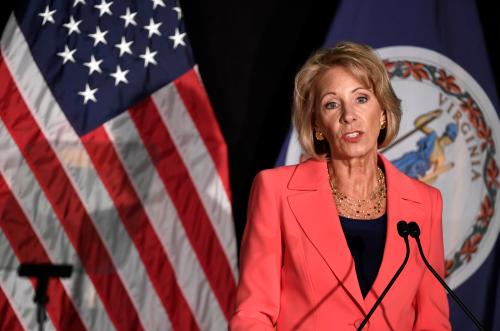While school was out this summer, the National Academy of Sciences published the over 300-page report, “Sexual Harassment of Women: Climate, Culture, and Consequences in Academic Sciences, Engineering, and Medicine.” The report is what you would expect from the National Academy: lots of numbers and a couple hundred references to the scientific literature. Included are a number of positive suggestions for reducing sexual harassment in academia—more on some of these below—but the report has one finding that shocked me.
I think of universities as pretty decent places to work; while there are certainly individual squabbles—sometimes serious ones—academics are pretty reasonably behaved for the most part. But, shockingly, that’s not what the evidence says when it comes to sexual harassment. According to the National Academy: “[Among employees], the academic workplace … has the second highest rate of sexual harassment at 58 percent (the military has the highest rate at 69 percent) when comparing it with military, private sector, and the government, where a broad definition of sexual harassment is used.”
Worse than the private sector? 58 percent? (Reports of harassment of students by faculty or staff are also high, in the 20-50 percent range.) Despite surface appearances, sexual harassment in academia turns out to be a major concern. While the pervasiveness is a surprise, some of the causes are not. My observation is that, in academia, there are three elements that contribute to such rampant sexual harassment:
- Power and silos
- Institutional “see-no-evil”
- Plain, old insensitivity
Something true in both the military and in the academy is that there are many relationships in which the power between two people is extremely unequal. In the private sector, usually the worst someone can do to you is fire you, and even then there are always other jobs. In academia, one person may be in a position to effectively end the other person’s academic career—not just interfere with their current position. (The power structure in the military as compared to civilian society is pretty obvious.) In most organizations, there is at least some avenue of appeal from perceived unfair treatment. In contrast, if I give a student a failing grade, tell a Ph.D. candidate that their dissertation isn’t acceptable, write a referee report judging that a journal ought to reject a submitted paper, or vote against someone’s tenure, the truth is there is little to no recourse.
The problem of power is reinforced in academia because organization is so “siloed.” When I’m advising a Ph.D. student, basically no one else knows what I’m doing and probably no one else on campus could judge whether the mentor/mentee relationship is reasonable, even if they could observe it. The fact that so much interaction is effectively private reinforces the risk of bad behavior where there is a power imbalance. Interestingly, the National Academy study finds the greatest incidence of sexual harassment happens in medicine, which is especially hierarchical: “Research on the medical environment reveals that overall ‘mistreatment’ is commonplace in all levels of the medical hierarchy, especially among medical school students, interns, and residents.”
On the second bullet point, the National Academy study says, “Too often, judicial interpretation of Title IX and Title VII has incentivized institutions to create policies and training on sexual harassment that focus on symbolic compliance with current law and avoiding liability, and not on preventing sexual harassment.”
If you are reading this from a university, when is the last time you heard about a significant punishment to a colleague for egregious sexual harassment? If you were the subject of sexual harassment (I’m hoping you find this a hypothetical question, but in light of the study’s finding I’m no longer so sure this is merely hypothetical for most readers), would you feel it worth the cost and risk to file a complaint? Here, there are two different issues. The first issue is whether the campus takes sexual harassment seriously. The second issue is whether the campus makes public the extent to which there are consequences of bad behavior. If you want to deter misbehavior, be sure that there are consequences and everyone on campus knows it. If you want victims to come forward, they need to know that complaints result in actions.
As a positive example of good reporting, the National Academy study praises Yale’s semiannual “Reports of Complaints of Sexual Misconduct”: “These reports are written to protect anonymity while also providing minimal descriptions and statistical summaries that reveal (1) the complainants and respondents role in the university …and (2) the status of the complaint (if the complainant decided to pursue a formal complaint, if investigation is pending, any action taken by the university after investigation.”
So reporting can be done. It’s not that hard. And frankly, making data public is an important step in bringing a university community together when improvements are needed. A university would likely prefer not to read about unsuccessful processes from an external source, such as the recent California state auditor’s report, “The University of California: It Must Take Additional Steps to Address Long-Standing Issues With Its Response to Sexual Harassment Complaints.”
Most harassment stops short of coercion and assault. The National Academy cites a large study done at Penn State of faculty/staff-on-student harassment for female students. About 95 percent of misbehavior falls into the categories of “sexist hostility” and “crude behavior.”

So a little advice to faculty, staff, and teaching assistants who either don’t care how women feel or who—despite all the attention the subject has gotten—still don’t understand how women feel. Don’t make sexual remarks. The fact that women may laugh or go along doesn’t make it okay, because some of them won’t feel they have a choice, and you won’t know that. The issue isn’t whether sexual banter can be fun for everyone—the issue is that you won’t know if you’re making people uncomfortable (unless, of course, they file a complaint against you).
Keep inappropriate comments and “jokes” out of your professional life. Why? Because you know that you might be making someone uncomfortable when that’s not your intention at all. What’s more, you are setting an example. So keep it professional.
One final comment from the report for those who are onboard with improving the situation:
Taken together, the surprisingly sparse—yet robust—set of studies on sexual harassment trainings shows that trainings can improve knowledge of policies and awareness of what is sexual harassment; however, trainings have either no effect or a negative effect on preventing sexual harassment.
Given … that actions can be taken to inhibit sexually harassing behavior … and that changing attitudes is difficult, effort seems better spent on developing and using sexual harassment trainings aimed at changing people’s behaviors rather than on their attitudes and beliefs. Ultimately, it is individuals’ actions and behaviors that both harm targets and are illegal, not their thoughts.







Commentary
It happens here, too: Lessons for universities on preventing sexual harassment
September 14, 2018